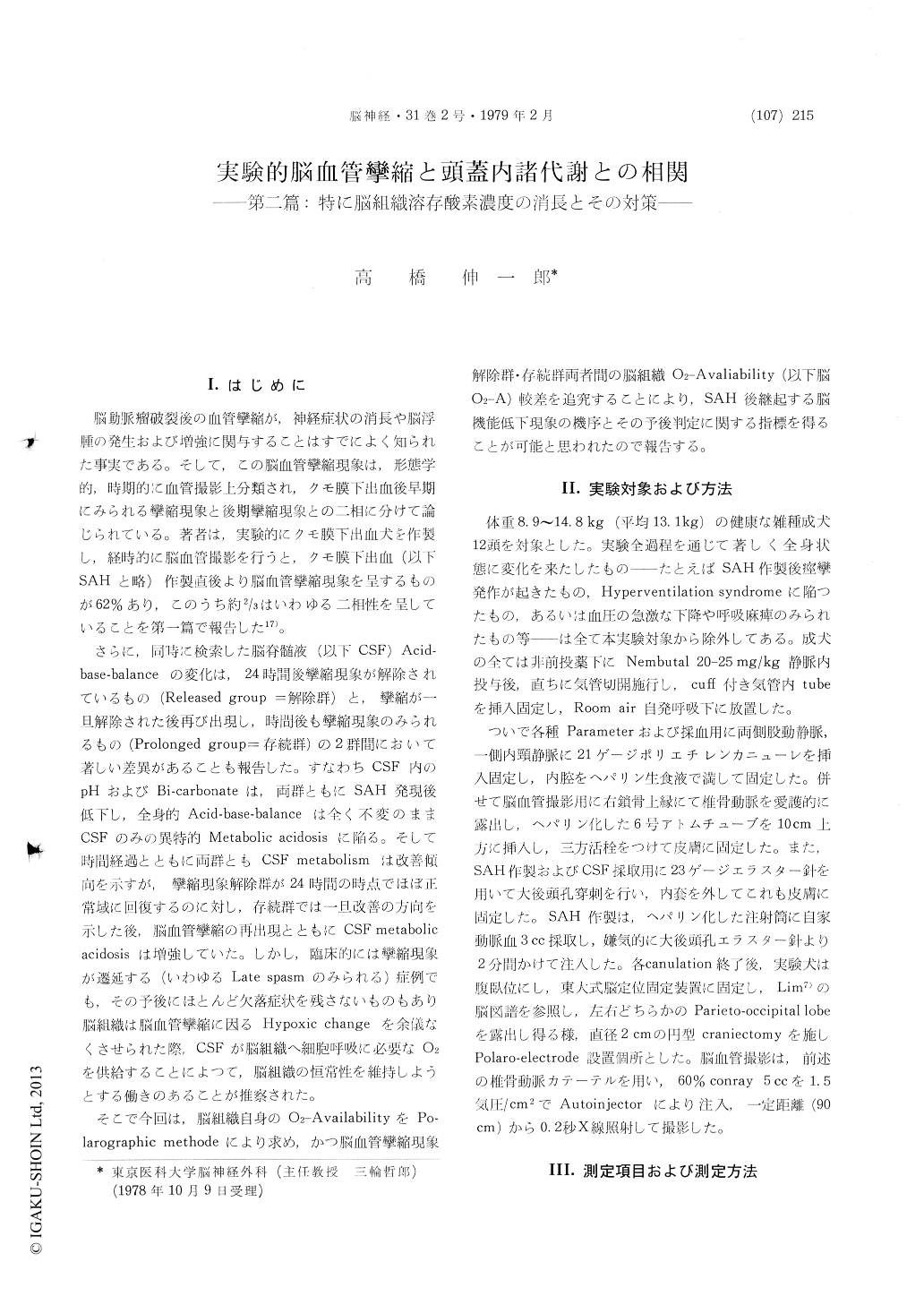Japanese
English
- 有料閲覧
- Abstract 文献概要
- 1ページ目 Look Inside
I.はじめに
脳動脈瘤破裂後の血管攣縮が,神経症状の消長や脳浮腫の発生および増強に関与することはすでによく知られた事実である。そして,この脳血管攣縮現象は,形態学的,時期的に血管撮影上分類され,クモ膜下出血後早期にみられる攣縮現象と後期攣縮現象との二相に分けて論じられている。著者は,実験的にクモ膜下出血犬を作製し,経時約に脳血管撮影を行うと,クモ膜下出血(以下SAHと略)作製直後より脳血管攣縮現象を呈するものが62%あり,このうち約2/3はいわゆる二相性を呈していることを第一篇で報告した17)。
さらに,同時に検索した脳脊髄液(以下CSF) Acid—base-balanceの変化は,24時間後攣縮現象が解除されているもの(Released group=解除群)と,攣縮が一旦解除された後再び出現し,時間後も攣縮現象のみられるもの(Prolonged group=存続群)の2群間において著しい差異があることも報告した。すなわちCSF内のpHおよびBi-carbonateは,両群ともにSAH発現後低下し,全身的Acid-base-balanceは全く不変のままCSFのみの異特約Metabolic acidosisに陥る。そして時間経過とともに両群ともCSF metabolismは改善傾向を示すが,攣縮現象解除群が24時間の時点でほぼ正常域に回復するのに対し,存続群では一旦改善の方向を示した後,脳血管攣縮の再出現とともにCSF metabolicacidosisは増強していた。しかし,臨床的には攣縮現象が遷延する(いわゆるLate spasmのみられる)症例でも,その子後にほとんど欠落症状を残さないものもあり脳組織は脳血管攣縮に因るHypoxic changeを余儀なくさせられた際,CSFが脳組織へ細胞呼吸に必要なO2を供給することによつて,脳組織の恒常性を維持しようとする働きのあることが推察された。
The purpose of this paper is to describe the oxygen availability of cerebral tissue in dogs during experimental subarachnoid hemorrhage.
Oxygen availability was measured by polaro-graphic technique using a hydron membrane coatedgold electrode. This study was performed about Acid-base-balance of cerebral blood, cerebrospinal fluid and cerebral O2-availability in 12 adult dogs showing cerebrovascular spasm following the ex-perimental production of subarachnoid hemorrhage.
Cerebrovascular spasm was shown in biphasic nature.
In 7 dogs the spasm was nonexistent at 24 hours later (spasm released group), while in the other 5 dogs the spasm recurred at 12 to 24 hours after once released (spasm prolonged group). In the spasm prolonged group, there was atypical metabolic acidosis in cerebrospinal fluid, which continued protractedly. Metabolic changes of cerebrospinal fluid in the spasm released group were of a transient duration. In both groups cerebral O2-availability suggested severe hypoxia after the onset of sub-arachnoid hemorrhage but tended to be restored to normal 3 hours later. Whereas cerebral O2-avail-ability of the spasm released group returned to almost normal levels, this parameter stopped in half level of normalization in the spasm prolonged group, and showed plateau wave afterwards without re-ponding to recurrent spasm.
Cerebral O2-availability in the spasm prolonged group suggests that oxygen was supplied from cerebrospinal fluid, as showed by a protracted fall of cerebrospinal fluid PO2.
It is speculated that so-called late spasm is assumed to depend upon cerebrospinal fluid metabolites. For purpose of improvement of cerebro-vascular spasm, the correction of CSF acidosis was attempted by injection of NaHCO3 in subarachnoidal cistern.

Copyright © 1979, Igaku-Shoin Ltd. All rights reserved.


